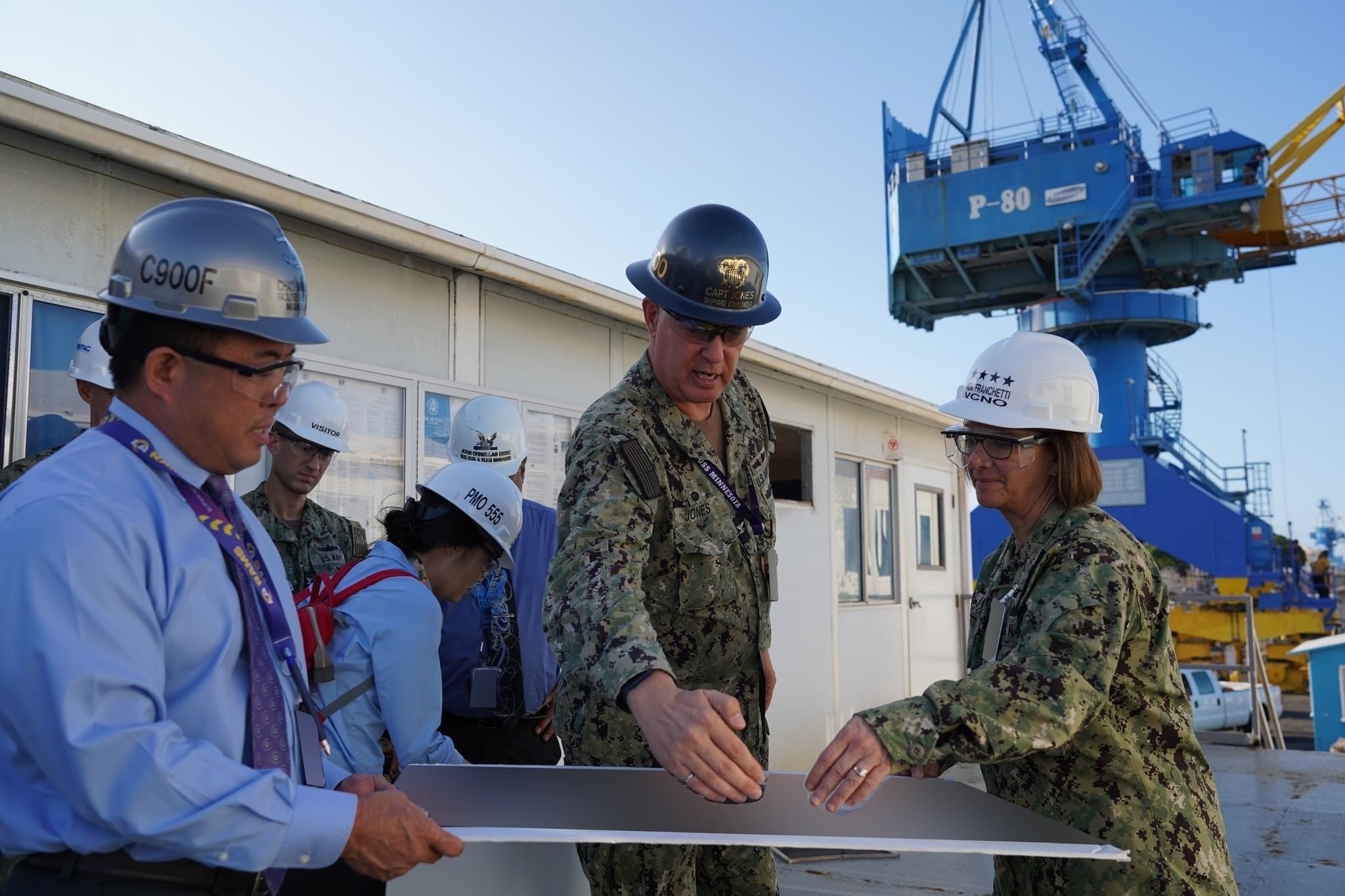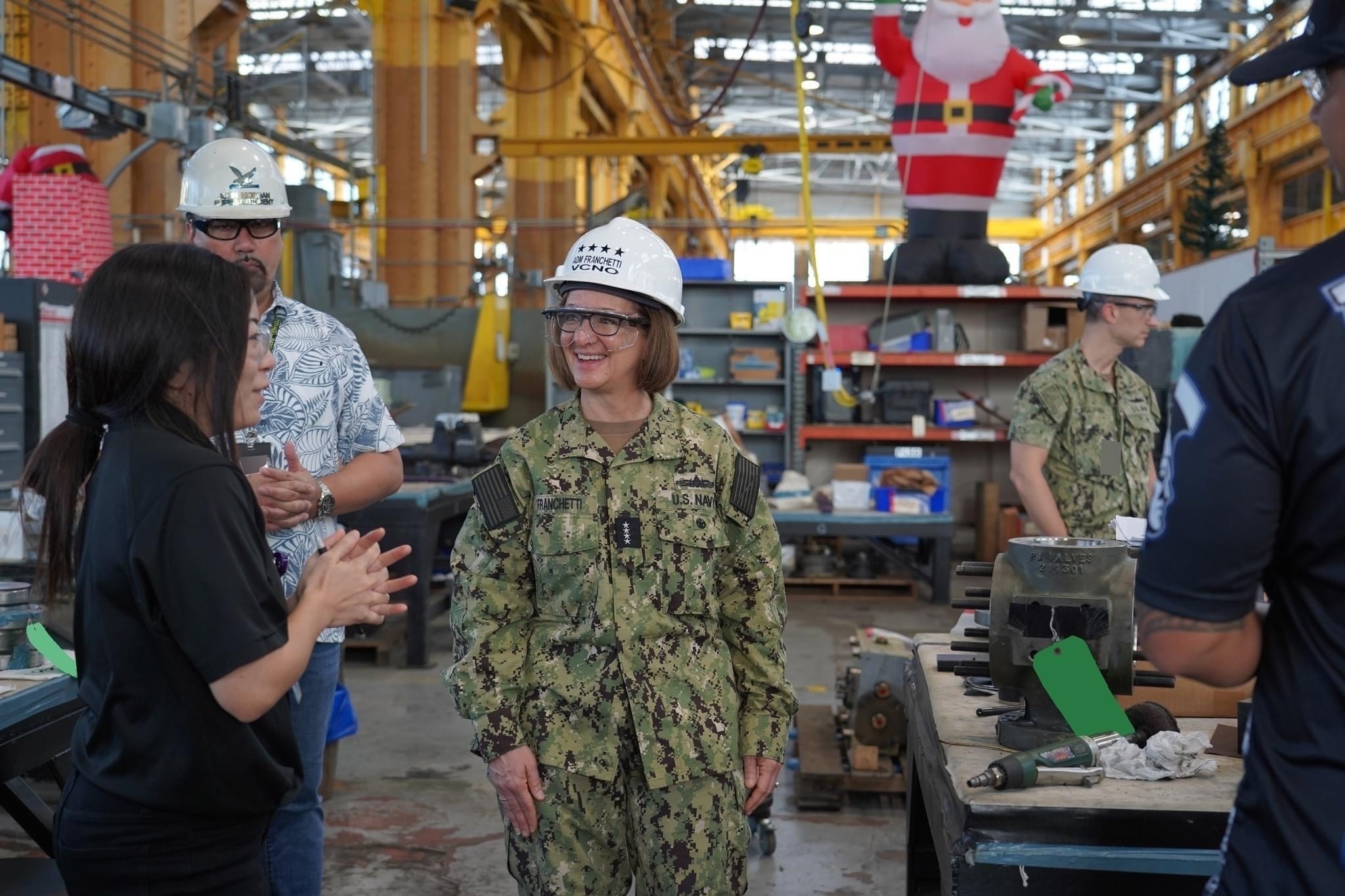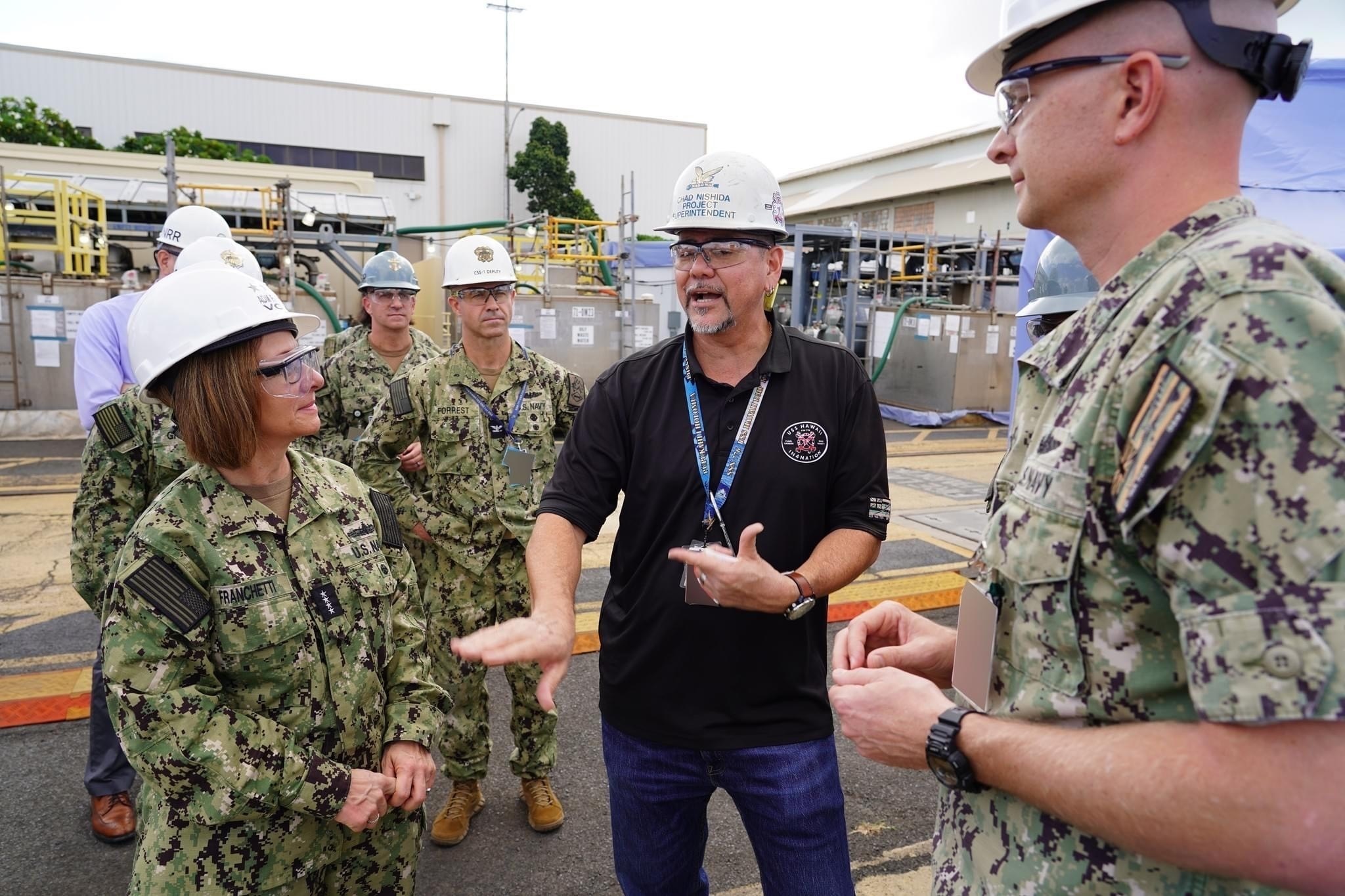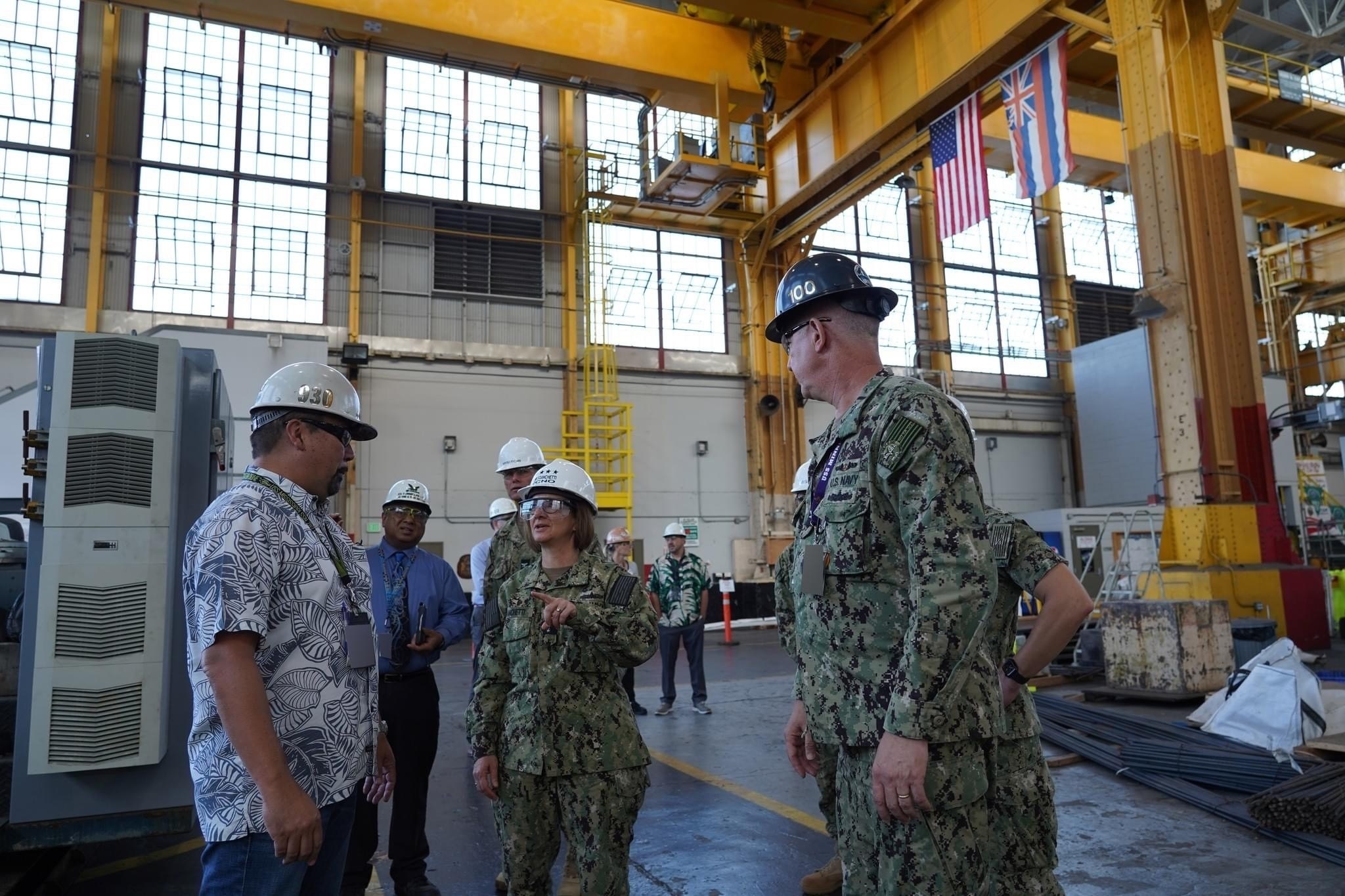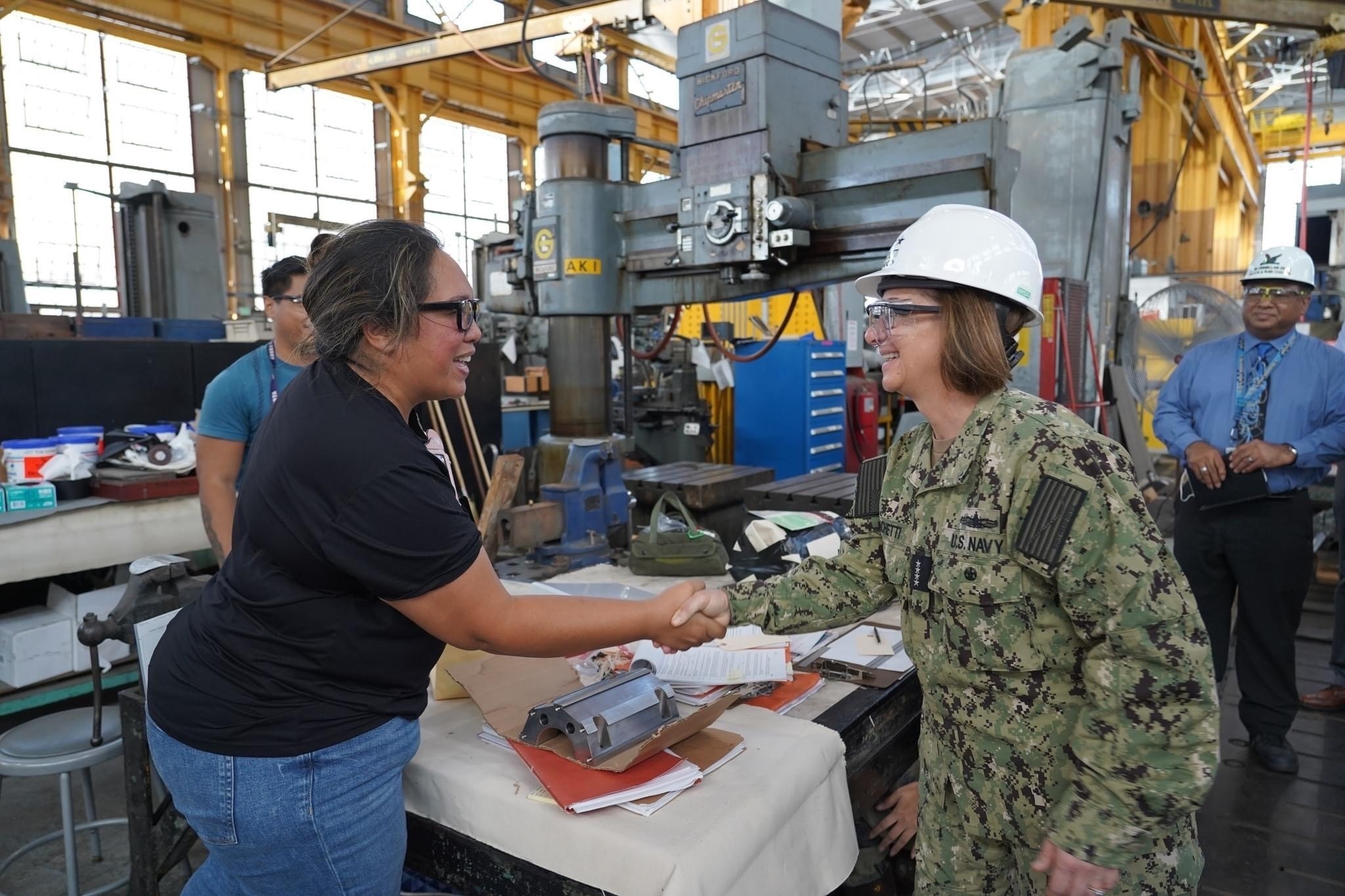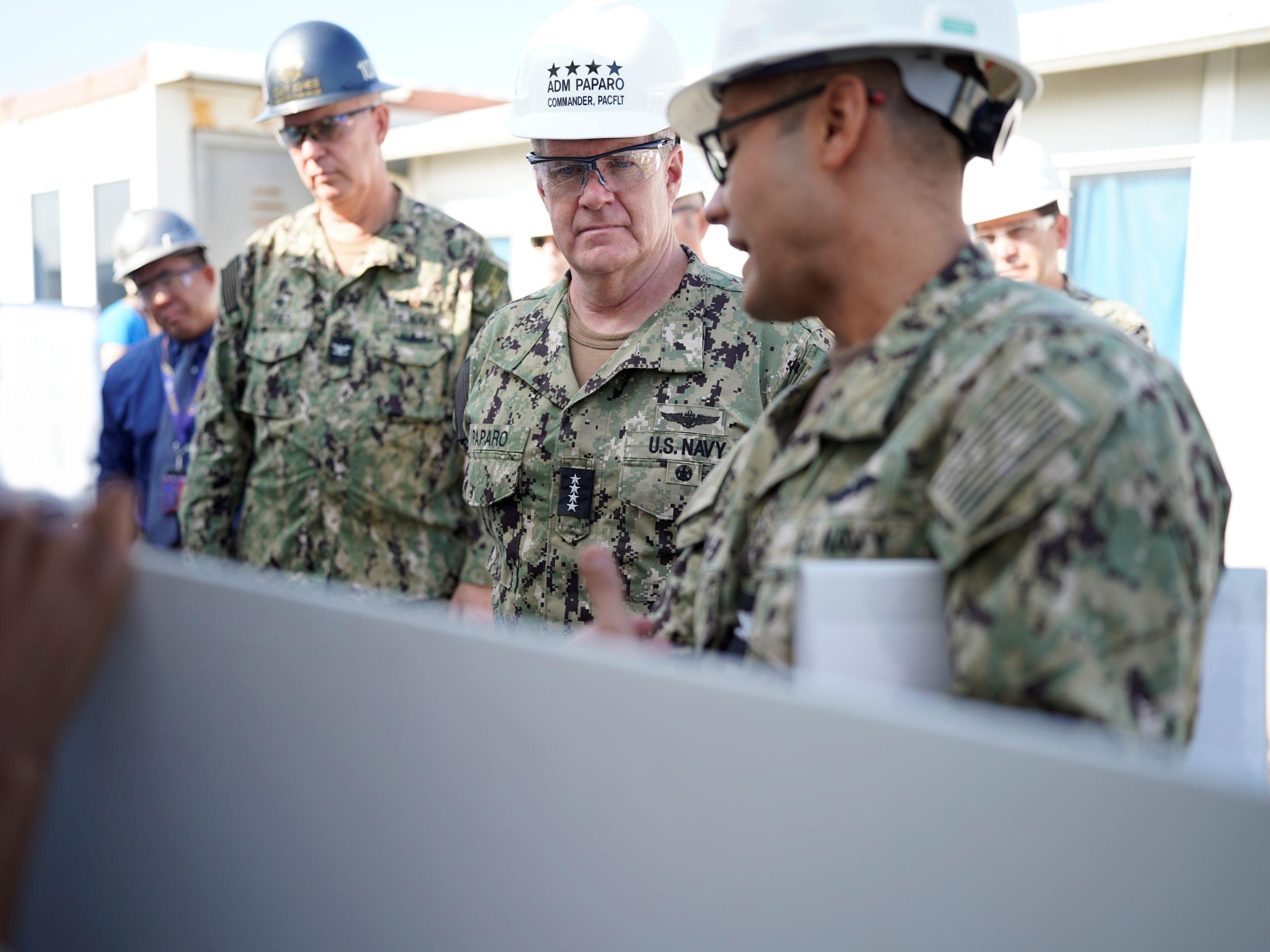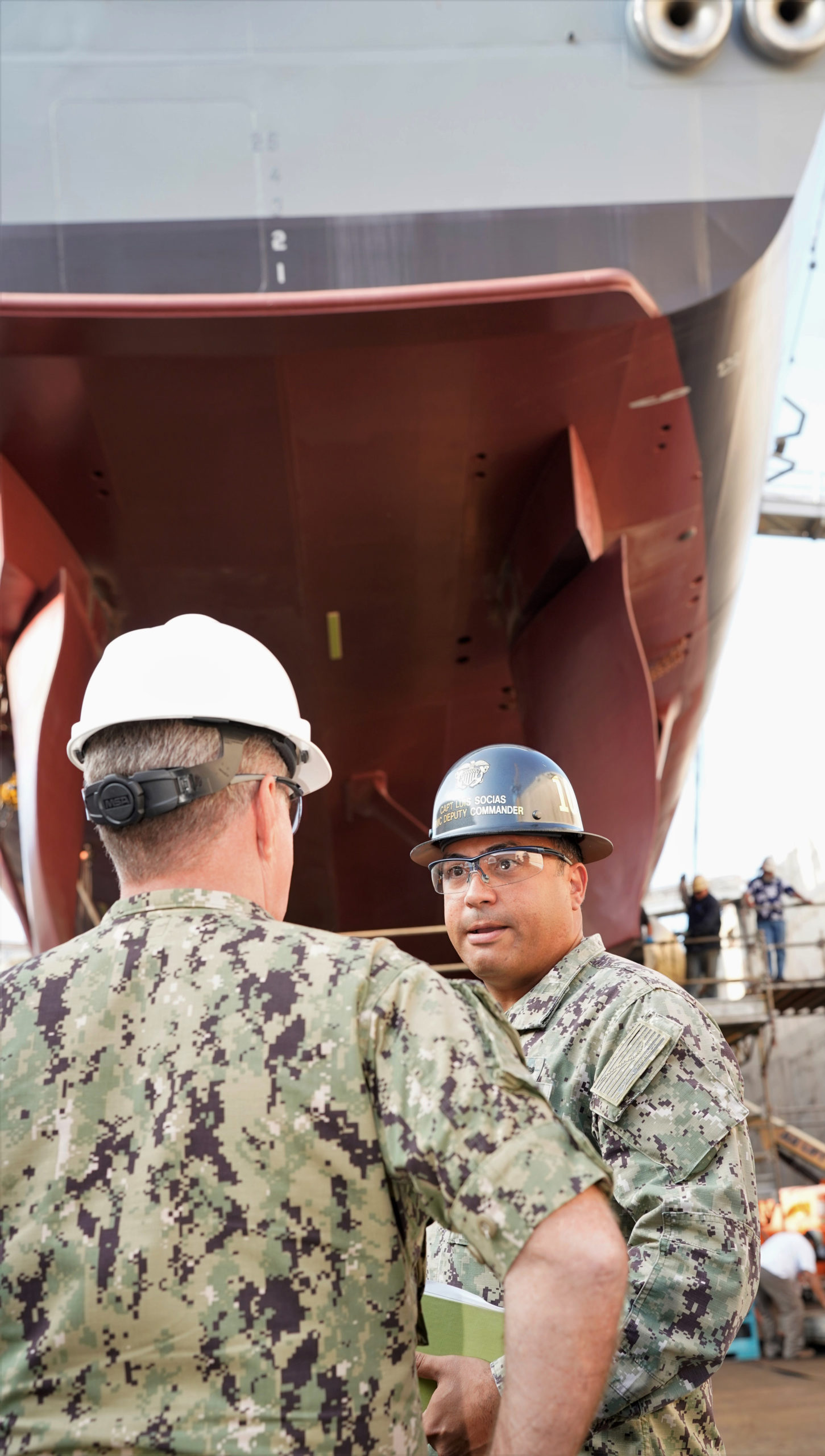By Robbin Laird
As the U.S. Navy works its ability for distributed operations with integrated effects, how will the fleet be supported and sustained?
One answer to that question is the major challenge of rebuilding the fleet’s maintenance infrastructure.
Years of just-in-time maintenance, supporting wars of choice not wars of necessity, have highlighted the need to invest in the ability to turn U.S, Navy ships out from maintenance in a timely manner and to have the requisite trained workforce to support enduring operations in a high tempo conflict.
Although increasingly recognized as a key priority, rebuilding the U.S. Navy’s maintenance infrastructure takes not only time and money, but the human capital to maintain a fleet built for enduring operations.
Unlike China, U.S. maintenance yards need to be redesigned and upgraded to support comprehensive and efficient operations of a modern combat fleet.
What is the U.S. Navy doing to right the ship, with regard to maintainability?
During my late April 2023 visit to Honolulu, I sat down with Captain Richard Jones, Commander of Pearl Harbor Naval Shipyard and Intermediate Maintenance Facility (PHNSY & IMF), to discuss how they are shaping a way ahead that both enhances near-term capabilities and looks ahead to meet the Pacific’s challenging strategic environment .
Simply put, the key metric of a shipyard is the speed at which ships under maintenance are returned to combat commanders. Shipyards must continually look for opportunities and methods to ramp up the maintenance period rate, particularly when considering the possibility of sustained conflict against a peer competitor.
With the recognition that shipyards must become more efficient, the Navy established the Shipyard Infrastructure Optimization Program (SIOP) program office in May 2018. As the Navy has described this effort:
The Navy’s four public shipyards — Norfolk Naval Shipyard (NNSY), Portsmouth Naval Shipyard (PNSY), Puget Sound Naval Shipyard and Intermediate Maintenance Facility (PSNS&IMF), and Pearl Harbor Naval Shipyard and Intermediate Maintenance Facility (PHNSY&IMF) — perform a vital role in national defense by executing maintenance on submarines and aircraft carriers in order to provide combat-ready ships to the fleet.
Originally designed and built in the 19th and 20th centuries to build sail- and conventionally-powered ships, the Navy’s public shipyards are not efficiently configured to maintain and modernize nuclear-powered aircraft carriers and submarines.
With the Navy’s needed focus on operations, the aging shipyards have been unable to adequately sustain and optimize their facilities, utilities, dry docks, equipment and information technology infrastructure. These inefficiencies and obsolete facilities result in higher maintenance costs, schedule risks and reliability issues.
To create the shipyards that our nation needs requires making significant investments to modernize dry docks, optimize industrial processes and modernize standard equipment to bring these critical industrial sites to modern standards.
To meet that mission, the Navy established the Shipyard Infrastructure Optimization Program (SIOP) program office in May 2018. The SIOP Program Office (PMO 555) is under the Program Executive Office (PEO) Industrial Infrastructure (II), which was established in Fiscal Year 2022 as a Naval Facilities Engineering Systems Command (NAVFAC) affiliated PEO and is responsible for the cost, schedule, and performance of SIOP. PEO II reports to the Assistant Secretary of the Navy for Research, Development, and Acquisition (ASN RD&A).
The Navy will ensure that the optimization process fully integrates environmental considerations including natural and cultural resources, water and air quality, and more. During the development of individual shipyard plans, the Navy will develop alternatives for assessment under the National Environmental Policy Act (NEPA), Endangered Species Act (ESA) and the National Historic Preservation Act (NHPA). The Navy will work with stakeholders as part of the decision-making process and will conduct all appropriate NEPA, natural resource and NHPA analyses; agency and government-to-government consultations and public engagement and obtain all required permits to ensure a proactive approach to environmental protection.
With the breadth and depth of needs, the SIOP program has a significant workload to deliver the critical warfighting infrastructure enabling a distributed fleet to operate effectively in crisis and combat situations.
A Government Accountability Office (GAO) report on SIOP indicated the steps SIOP has taken to recapitalize its shipyards:
The Navy has taken several actions to improve its public shipyards in recent years. In 2018, the Navy began an effort to modernize and optimize its shipyards, known as the Shipyard Infrastructure Optimization Plan (SIOP). The Navy has also implemented some GAO recommendations in its efforts to improve shipyards, such as creating a program office to manage the SIOP. In addition, the Navy invested in shipyard infrastructure above the minimum level set by Congress. Finally, the average condition of facilities at Navy shipyards has improved at three of the four shipyards from 2016 to 2020.
In addition to the progress enumerated by GAO, SIOP has commenced the second phase of industrial modeling for all four shipyards to provide data for optimized workflows and has begun the project planning studies for Waterfront Production Facility (WPF) at Pearl Harbor. A task order has been awarded for construction of the new Dry Dock 5 at Pearl Harbor, and multiple Facilities, Sustainment, Restoration, and Modernization (FSRM) projects to maintain the shipyards’ mission readiness have been executed.
SIOP will continue to “recapitalize the four public shipyards to optimize maintenance production by correcting infrastructure and equipment condition, configuration, capacity, and resiliency shortfalls,” according to Mr. Mark Edelson, the head of the program executive office, Industrial Infrastructure (PEO II). . “The happiest Fleet Commanders have the ships required to fulfill forward presence commitments.” PEO II has oversight of the Shipyard Infrastructure Optimization Program, which is a holistic plan that integrates all infrastructure and industrial plant equipment investments at the Navy’s four public shipyards to meet nuclear fleet maintenance requirements.
In my discussion with Captain Jones, he identified a number of attributes needed for mission success and how PHNSY & IMF is working to build these areas.
A key attribute – and one he emphasized – was having a skilled, capable and motivated workforce. He noted that for nearly a decade, the shipyard did not hire new staff, prior to the refocus on the great power competition. This led to a major hiring gap which meant they had an experienced but aging workforce. With the returned focus and renewed appreciation of the yards not to mention an increased workload, the shipyard began bringing many new hires onboard.
With this new workforce, the question became, “how to close the gap and ensure proper transfer of skills to the new hires while simultaneously taking in new types of learning and skills?” The new personnel brought new perspectives, approaches and techniques. Captain Jones indicated that they have been able to blend the old with the new to create a highly effective workforce.
He noted: “If you look at the people coming in, they see the work differently. We don’t accept every idea they propose, but we do we listen and take those ideas into account because they may have a great idea that nobody’s ever thought of before.”
New teaching approaches have helped as well. Captain Jones highlighted the use of virtual reality training. He gave two examples, welding and crane operations. With regard to welding skills, students wear a virtual welding hood that is a simulator.
“It actually feels like you’re holding welding rod. The computer system can tell how hard you’re pressing on it and if you’re pressing on it at the right angle,” Jones said. “When you’re looking through the hood, you see what you would see during an actual welding operation.”
He also described the crane operation training: “We have a rigging trainer for crane operators. When they have their virtual reality hood on, they are in the cab of the crane and have the same controls. When you’re wearing the virtual reality hood, sitting in the chair, it’s very life-like, similar to being in the crane. It really speeds up the training because it doesn’t take a physical crane off operations and it’s much safer because the trainees can make mistakes virtually and not damage anything.”
While the training the workforce receives is a cornerstone of the shipyard, it is also the workforce themselves both as individuals and as a team which is crucial to the success of the shipyard. Captain Jones underscored the workforce is motivated to join PHNSY & IMF. Not only do they have many more Apprentice Program applicants than available openings each year, but they are part of the local community through sports teams, teaching in colleges and universities, mentoring young scientists in STEM programs, and volunteerism.
The workforce also knows PHNSY & IMF has been and continues to be a vital asset to the Nation’s defense both in the past and today. One example is the significant role the shipyard played in World War II and in the following years, ensuring the Navy had the ships they needed to respond to any situation.
It is indeed gratifying to see a local community committed to the nation and its defense.
A second key attribute is to have the proper tooling and material for the repair process. Here the yard could use more investment in new tools and machinery, but the workers use a mix of the old and the new to good effect. As part of the SIOP program, assessments are underway to evaluate the various equipment throughout the shipyard so that upgrades can be made where needed.
Captain Jones noted, “Our machine shop actually uses some pre-World War II equipment. Some of these machines are extremely reliable and they almost never break down and are very good at doing certain things. For example, if we are only going to do single-type milling, it’s much faster to do it on the older machine. We have balance between the new and the old that seems to be working very well.”
A third key attribute also linked to the SIOP program is the process for redesign of the shipyard to support modern workflows to optimize the work process to speed up the ability to more rapidly do ship repairs. The need for these upgrades is linked to how the yard was established in 1908 and developed over time to meet the needs of that time.
SIOP has completed one phase of industrial modeling that shipyards can leverage to improve efficiency. Another phase of industrial modeling for Pearl Harbor and each of the other three shipyards has begun that will provide data for optimized workflows at the yards. This work will provide modeling data for workflows inside the facilities and will inform more detailed project level planning and design (P&D) for future SIOP construction projects.
Another element of this challenge is to enhance the digital backbone at the yard. When asked what Captain Jones would like to see in future investments, the digital backbone is clearly one capability which he felt needed to be enhanced.
Retired Adm. James Foggo emphasized the need for such investment in a 6 January 2023 article on the way ahead with regard to the SIOP. Foggo argued: “While improving the physical infrastructure of these facilities will be critical to success, it’s equally essential that we take this opportunity to build the digital infrastructure required to accelerate our readiness advantage.”
Captain Jones noted that they have established an innovation division within the shipyard which will facilitate the digital transition, such as using 3D printing and other technologies. “I think it’s a step in the right direction but we are still in the infancy stage.”
A fourth key attribute is simply adding more infrastructure capacity. The main effort of the yard is repair of submarines, but the yard does not have the dry docks it needs. The first SIOP related project is the construction of a new graving dry dock to accommodate for a now obsolete Dry Dock #3, which will be replaced by the new Dry Dock #5.
“Our first major project is a new Dry Dock #3 replacement, also known as Dry Dock #5, which will be deep enough, wide enough, long enough for our current SSNs and any future one that’s in the books for planning. There is also a Waterfront Production Facility we are going to put next to it and a pier that we need. We have very little pier space here that meets the requirements,” said Jones.
“Then there is this optimization piece. If you look at the shipyard, our first dry dock built in 1919 has all the work shops were right along next to it. Then we built dry docks 2, 3 and 4. But most of the workshops are still located around the first dry dock. This is not optimal for our workflow, and we need to bring workers closer to where the work instead of spreading the work all over the yard. A lot of time is consumed in transit throughout the yard. We have 1,000 engineers out of 6,000 civilians roughly, the majority of whom are on the fourth floor of this building which is quite far from the waterfront. Moving them down right above the production shops is key element for optimization.”
We also discussed battle-damage repair as illustrated by the yard’s participation in the last RIMPAC exercise. PHNSY Navy divers participated in simulated battle-damage repair on USS Denver.
As Edward Lundquist noted in an article on this event:
“Before going down on July 22, Denver made one more valuable contribution to the Fleet. Navy salvage and repair experts set explosive charges aboard the ship that enabled battle damage assessment (BDA) teams to respond to actual damage.
“According to Jamie Koehler a Naval Sea Systems Command spokesperson, the event exercised the capabilities and limitations of an expeditionary group of Reservist and Regional Maintenance Center (RMC) Sailors for emergent repair when paired with an emergent repair container capability.
“The event provided the opportunity to survey realistic blast damage and conduct planning to utilize the Emergent Repair Capability afforded by the Emergent Maintenance and Repair Container (EMARC) along with Surge Maintenance (SURGEMAIN) Navy Reservist Sailors to plan and execute emergent repair,” Koehler said. “Divers were offered a realistic training environment to learn how to assess battle damage and how to effectively repair the ship.”
“The training simulated exactly how a ship would look after an attack or casualty and offered Mobile Diving Salvage Unit One and Pearl Harbor Naval Shipyard divers a chance to work as a team to assess, repair and return the vessel back to sea,” Koehler said. “Opportunities like this also identify future manning requirements, equipment shortfalls, and medical response preparations that can be measured appropriately.”
“Battle Damage Assessment Training aboard ex-USS Denver
- Commander, Navy Regional Maintenance Center (CNRMC) coordinated the availability of the EMARC containers.
- Hawaii Regional Maintenance Center provided Sailors an Engineering Assessment team support to the repair planning effort.
- SURGEMAIN provide Sailors and three Officers to support the assessment, planning and execution of repairs.
- MDSU-1 conducted Battle Damage Assessments (BDA) and notified PHNSY of their findings. Their knowledge of salvage equipment and techniques were used to complete the BDA evolution.
- PHNSY conducted Battle Damage Repair (BDR) and patch work to fix the damaged vessel based on MDSU-1’s recommendation. Our knowledge of patches and repair techniques were used to complete the BDR evolution.”
Let me conclude with a few final thoughts.
The challenge of ramping up the speed to deliver ships back to the operational fleet is a key part effective deterrence. It is also a challenge which requires strategic attention.
PHSNY & IMF is keenly aware of their strategic importance and the importance of meeting the key metric of the speed at which ships under maintenance are returned to combat commanders.. They are actively working to address the key areas of people, process and environment to successfully meet the nation’s needs today and into the future.
Captain Jones, Commander of Pearl Harbor Naval Shipyard and Intermediate Maintenance Facility (PHNSY & IMF)
Captain Richard Jones enlisted in the U.S. Navy in 1985. After completing Electrician’s Mate and Naval Nuclear Power Training, he was assigned to USS Truxtun (CGN 35).
He left active service in 1991 to complete a Bachelor of Science and Master of Science in Engineering at Purdue University. While at Purdue, he joined the U.S. Army Reserve and deployed in support of peacekeeping efforts in Bosnia.
After graduating in 1997, Capt. Jones worked for the Schlumberger Corporation aboard a seismic surveying vessel. During this time, he received a direct commission into the U.S. Navy Reserve as an Engineering Duty Officer (EDO) in 1999. He then joined the federal workforce as a civilian nuclear engineer at Portsmouth Naval Shipyard from 2000 to 2002 before his voluntary recall to active duty in 2002.
He received a Naval Engineer’s degree and Master of Science in Systems Engineering and Management from Massachusetts Institute of Technology in 2008.
His nuclear engineering duty officer tours include qualification while serving as Shipyard Docking Officer and Assistant Project Superintendent (Nuclear) at Portsmouth Naval Shipyard; Course Director of the Navy’s Engineering Duty Officer School where he also deployed to Iraq in support of Operation Enduring Freedom; Virginia-class Submarine Maintenance Coordinator at Supervisor of Shipbuilding, Conversion and Repair (SUPSHIP) in Groton, Conn.; Submarine Repair Officer at Norfolk Naval Shipyard; and Chief Engineer aboard USS Ronald Reagan (CVN 76).
In 2017, Capt. Jones joined Pearl Harbor Naval Shipyard & Intermediate Maintenance Facility first as the Production Resources Officer and then as Operations Officer. He joined Commander Submarine Force, Pacific Fleet as the Maintenance, Readiness, and Improvements Officer (N43) in 2020.
In June 2021, Capt. Jones assumed command of Pearl Harbor Naval Shipyard & Intermediate Maintenance Facility, the Navy’s comprehensive fleet repair and maintenance facility between the U.S. West Coast and the Far East, strategically located in the heart of the Pacific and the largest industrial employer in the State of Hawaii with more than 7,000 civilians, military members and contractors.
Featured Photo: PEARL HARBOR, Hawaii (December 14, 2022) Vice Chief of Naval Operations Admiral Lisa Franchetti discusses plans for infrastructure improvements under the Shipyard Infrastructure Optimization Program (SIOP) with Shipyard Commander Captain Richard Jones, and Production Facilities and Plant Equipment Manager Chad Nakamoto at Pearl Harbor Naval Shipyard & Intermediate Maintenance Facility (PHNSY & IMF) during a visit for an operations update and SIOP tour onboard Joint Base Pearl Harbor-Hickam. PHNSY & IMF is a field activity of NAVSEA and a one-stop regional maintenance center for the Navy’s surface ships and submarines. (U.S. Navy photo by Justice Vannatta/Released).


